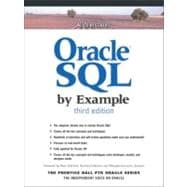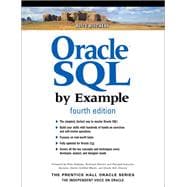Oracle SQL by Example

Oracle SQL by Example
- ISBN 13:
9780131451315
- ISBN 10:
0131451316
- Edition: 3rd
- Format: Paperback
- Copyright: 06/17/2004
- Publisher: Pearson
- Newer Edition
Note: Supplemental materials are not guaranteed with Rental or Used book purchases.
Extend or Purchase Your Rental at Any Time
Need to keep your rental past your due date? At any time before your due date you can extend or purchase your rental through your account.
Summary
Introduction
The SQL language is the de facto standard language for relational databases, and Oracle's database server is the leading relational database on the market today. The Oracle by Example, third edition, presents an introduction to the Oracle SQL language in a unique and highly effective format. Rather than being a reference book, it guides you through the basic skills until you reach a mastery of the language. The book challenges you to work through hands-on guided tasks rather than read through descriptions of functionality. You will be able to retain the material more easily and the additional example questions reinforce and further enhance the learning experience.
Who This Book Is For
This book is intended for anyone requiring a background in Oracle's implementation of the SQL language. In particular, application developers, system designers, and database administrators will find many practical and representative real-world examples. Students new to Oracle will gain the necessary experience and confidence to apply their knowledge in solving typical problems they face in the work situation. Individuals already familiar with Oracle SQL but wishing a firmer foundation or those interested in the new Oracle 10g features will discover many of the useful tips, tricks, and information.
The initial audience for the book was the students of the Oracle SQL class at Columbia University's Computer Technology and Applications program. The student body has a wide-ranging level of technology experience. Their questions, learning approaches, and feedback provided the framework for this book. Many students cited the hands-on exercises as critical to their understanding of database technology and the SQL language and continuously asked for more examples and additional challenging topics. This book shares much of the material presented in the classroom and looks at the various angles of many solutions to a particular issue.
The book begins with the basic concepts of relational databases, the SQL*Plus environment, and SQL; it then gradually deepens the knowledge. A reader who already has some fundamental understanding of SQL will benefit from reading this book as it allows him/her to gain a better insight to writing alternative SQL statements. After performing the exercises in this book, you will harness the power of SQL and utilize much of Oracle's SQL functionality.
What Makes This Book Different
This book encourages the reader to learn by doing; this requires active participation by performing the exercises. Ultimately, the reward is a thorough understanding of SQL and a high level of comfort dealing with the real-world Oracle SQL topics. Performing the exercises help with the retention of the material, and the Self-Review and Test Your Thinking sections further test your understanding and offer additional challenges. The companion Web site contains solutions to the Test Your Thinking exercises and includes additional exercises and answers.
The book's focus is to give the readers examples of how the SQL language is commonly used, with many exercises supporting the learning experience. Unlike other SQL books, this book discusses Oracle's specific implementation of the language. Learning the language alone is not enough. The book also teaches you how to adopt good habits and educates you about many Oracle-specific technology features that are essential to successful systems development. The examples are derived from a sample database that takes you through the typical tasks you will encounter when working with an Oracle database.
This book is not a reference book but rather it teaches SQL by illustrating its use through many examples. Use the index to lookup previously discussed concepts or refer back to certain topics. The best way to learn the SQL language is to perform the exercises and compare your answers with the sample answers and accompanying explanations. After you have completed the exercises, the companion Web site contains additional questions to test your understanding. It also lists the solutions to the Test Your Thinking exercises at the end of each chapter. You can access the companion Web site at http://www.phptr.com/rischert3e.
This book does not cover the entire Oracle SQL syntax, but emphasizes the essentials of the most-frequently used features with many examples to reinforce the learning. Some of Oracle's syntax options are too numerous and many very infrequently used; including them all would make the book swell by a several hundred additional pages. Instead, I have concentrated on those that you will use most. After performing the exercises, you will also have gained sufficient knowledge to read-up and understand the Oracle documentation, if needed. I hope that you will enjoy this learning experience and come away with the knowledge you hoped to gain.
How This Book Is Organized
Each chapter of the book is divided into labs covering a particular topic. The objective of each lab is defined at its beginning, with brief examples that introduce the reader to the covered concepts.
Following the lab's introductory examples are exercises that are the heart of the lab which reinforce and expand the reader's knowledge of the subject. Each exercise consists of a series of steps to follow to perform specific tasks, or particular questions that are designed to help you discover the important aspects of the SQL language. The answers to these questions are given at the end of the exercises, along with more in-depth discussion of the concepts explored.
After you perform the exercises and compare the answers with the sample queries, answers, and explanations, the lab ends with multiple-choice Self-Review questions. These are meant to test that you have understood the material covered in the lab. The answers to these questions appear in Appendix A. There are additional Self-Review questions at this book's companion Web site.
At the end of each chapter, the Test Your Thinking section reinforces the topics learned in labs, and solidifies your skills. The answers to these questions are found on the companion Web site for this book.
Layout of a Chapter
- Chapter
- Lab
- Exercises
- Exercise Answers (with detailed discussion)
- Self-Review Questions
- Lab ...
- Test Your Thinking Questions
- Lab
The chapters should be completed in sequence because concepts covered in earlier chapters are required for the completion of exercises in later chapters.
About the Companion Web Site
The companion Web site is located at http://http://www.phptr.com/rischert3e. Here you will find a number of very important things:
-
Installation files you need before you begin reading the book.
-
Answers to the Test Your Thinking questions.
-
Additional Self-Review questions.
-
Additional Resources such as links, tips, and errata
Installation Files
All of the exercises and questions are based on a sample schema called STUDENT. The required files to install this STUDENT schema and the installation instructions can be downloaded from the Web site.
Test Your Thinking
The answers to the Test Your Thinking sections are found at the Web site.
Additional Self-Review Questions
The Web site will have many other features, such as additional Self-Review questions, a message board, and periodically updated information about the book.
Vis








